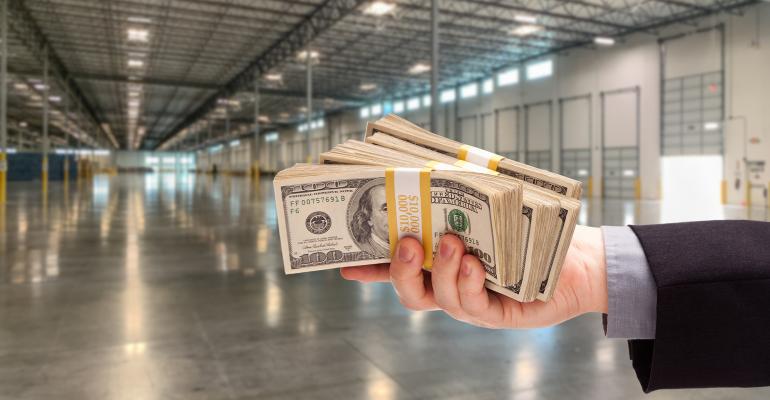With industrial real estate values at record levels and cap rates compressing by 50 to 75 basis points year-over-year by the end of 2021, one would expect investors to be backing off a bit. But that just isn’t happening in today’s market, according to Chris Riley, vice chairman with CBRE’s investment properties group based in Atlanta. “There’s been no pullback in appetite or transaction activity for industrial properties.” In fact, he notes that aggressive industrial acquisition activity by large funds and institutional investors has ramped up.
Just this week, for example, CBRE Investment Management agreed to buy a global portfolio of logistics assets from Hillwood Investment Properties in a deal valued at $4.9 billion. The portfolio includes properties in both the U.S. and Europe, with two-thirds of the assets comprising leased existing buildings and one-third in various stages of development and leasing, according to The Wall Street Journal.
Three weeks ago, AXA Investment Management Alternatives acquired a 23-property industrial portfolio from Dermody Properties Industrial Fund II for $1.2 billion, with another deal under way with the same seller to buy nine industrial development projects for an additional $850 million.
And a month ago, Blackstone acquired Value Fund V from Cabot Properties for $2.8 billion. The fund contains 124 industrial properties in the U.S. and Europe.
Year-to-date through November 2021, industrial sales volume in the U.S. reached a record $129.9 billion, a 58 percent increase compared to an already strong year in 2020, according to real estate data provider Real Capital Analytics (RCA). That’s in a market where RCA’s Commercial Property Price Index (CPPI) for industrial properties rose by 22.1 percent year-over year, the most of any core property type the firm tracks.
During the month of November, Sweden-based EQT Exeter sold out of its EQT Exeter Industrial Value Fund IV, disposing of a 70.5-million-sq.-ft. U.S. industrial portfolio to global institutional buyers led by an Asian sovereign wealth fund for $6.8 billion. The fund’s properties include 328 modern supply chain and e-commerce facilities in markets including New York, Atlanta, Chicago, Dallas and Los Angeles, among others.
Meanwhile, some smaller deals closed in the fourth quarter of 2021 included GLP Capital Partners’ purchase of the four-property, 1-million-sq.-ft. Northeast Logistics Portfolio from Marcus Partners for $173 million and KKR’s acquisition of a 1.5-million-sq.-ft. industrial campus in Allentown, Penn. from GLP itself.
CBRE’s Riley attributes the continued record industrial investment activity to both the high level of demand for space from industrial tenants, especially e-commerce operators, and an extraordinary amount of investment capital available in the marketplace. In fact, Riley expects that real estate investors won’t be deterred from industrial acquisitions even if interest rates start to rise, as they are forecasting industrial rent growth that will exceed any potential increase in Federal Reserve’s benchmark interest rate. He adds that depending on the market, industrial rates went up from 5.0 percent to 15.0 percent year-over-year in 2021.
Research from CBRE shows that year-to-date through September 2021, industrial leasing volume in the U.S. reached 587 million sq. ft. of space, an increase of 52 percent compared to the year prior. Vacancy nationwide was averaging 4.0 percent, with rent growth at 9.7 percent year-over-year.
And commercial real estate services firm Cushman & Wakefield forecasts that industrial vacancy in North American markets will rise only modestly in 2022, to 4.1 percent. The firm’s researchers expect industrial rents to continue to increase well into 2023.
The steady increase in leasing demand and rising prices for industrial properties have driven up construction levels in the sector to record high, with industrial starts from the third quarter of 2020 through the third quarter of 2021 totaling $73 billion, according to RCA, an increase of 48 percent year-over-year.
Merchant builders are now constructing new product at record levels, the majority of it built on a speculative basis, leased up and then sold to investors, says Michael Marconi, senior executive vice president, industrial services, with commercial real estate services firm Transwestern.
“Everyone wants to be in the industrial sector,” Marconi says, noting that rising construction costs, along with competition for available properties, have kept values rising. With high demand and continued rent growth, even class-B or class-C assets are trading at record prices, he adds.
RCA research shows that in the third quarter of 2021, the most recent period for which data is available, cap rates on industrial acquisitions averaged 5.4 percent, lower than for any core property type save multifamily, and many transactions traded at cap rates below 4.0 percent.





